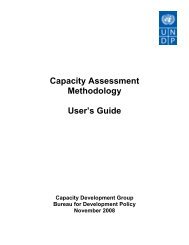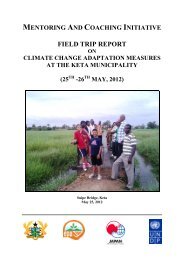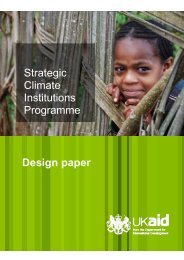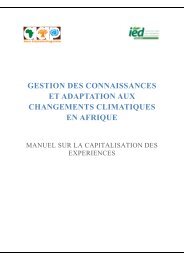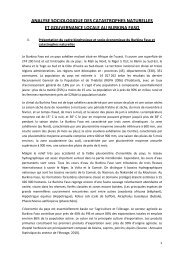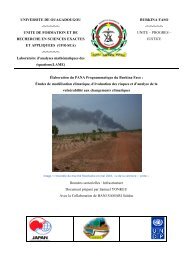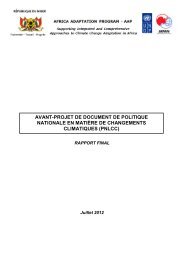Handbook of Capitalisation 2012.pdf - Africa Adaptation Programme
Handbook of Capitalisation 2012.pdf - Africa Adaptation Programme
Handbook of Capitalisation 2012.pdf - Africa Adaptation Programme
You also want an ePaper? Increase the reach of your titles
YUMPU automatically turns print PDFs into web optimized ePapers that Google loves.
<strong>Africa</strong> <strong>Adaptation</strong> <strong>Programme</strong><br />
<strong>Handbook</strong> on <strong>Capitalisation</strong> <strong>of</strong> Experiences 2012<br />
DEFINING THE AIMS OF THE CAPITALISATION PROCESS<br />
A capitalisaiton process, first <strong>of</strong> all, entails revisiting the capitalisation challenges for the<br />
organisation, within its specific context. Then one has to define the intended objective through<br />
the capitalisation process. Is it about facilitating ownership <strong>of</strong> the tool by other stakeholder<br />
groups or a process consisting <strong>of</strong> developing and implementing adaptation programmes? Does<br />
one seek to prepare an advocacy campaign on issues relating to climate change adaptation or<br />
is one aiming at formulating a fundraising plan to support local adaptation initiatives? Whatever<br />
the objectives <strong>of</strong> the capitalisation process, it is necessary to define them accurately from the<br />
start <strong>of</strong> the process.<br />
The capitalisation analytics and prioritization matrix allows one to collect information on the<br />
objectives <strong>of</strong> the capitalisation for the organisation, with strengths and assets lying in establishing<br />
a capitalisation system and the constraints one will need to tackle.<br />
Table 3: Analytical matrix showing the challenges and objectives <strong>of</strong> the capitalisation <strong>of</strong> the WFP-AAP project:<br />
Energy Saving Stoves in Institutions, Kenya<br />
Key questions<br />
What are the capitalisation<br />
challenges for your<br />
organisation?<br />
What are the capitalisation<br />
objectives for your<br />
organisation?<br />
What are the assets and<br />
opportunities that your<br />
organisation can <strong>of</strong>fer to a<br />
capitalisation system?<br />
Which (limiting) constraints<br />
must one face?<br />
Answers<br />
The project’s impacts are long term, which makes it difficult to<br />
document them in the short term<br />
It is difficult to access schools since most are located in remote areas<br />
The information provided by the schools are sometimes inaccurate<br />
Dissemination <strong>of</strong> fuel-efficient improved cooking stoves<br />
Establish sustainable financing mechanisms<br />
Establish sustainable sources <strong>of</strong> domestic fuel<br />
Commitment and interest in the project to share experiences<br />
stemming from it<br />
Availability <strong>of</strong> financial resources to support the capitalisation process<br />
A national context favourable to capitalisation through ICT<br />
development and the existence <strong>of</strong> several platforms on knowledge<br />
management<br />
Availability <strong>of</strong> resource persons able to conduct the capitalisation<br />
process<br />
Media commitment for the dissemination <strong>of</strong> knowledge on climate<br />
change<br />
Due to the cultural reality, the use <strong>of</strong> wood is still predominant<br />
A simplified formatting <strong>of</strong> technical data is <strong>of</strong>ten difficult<br />
28



